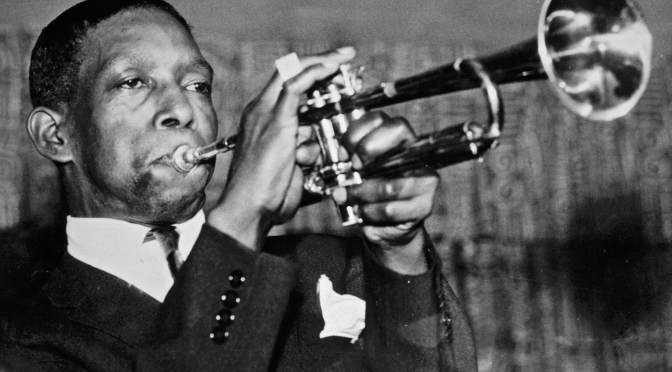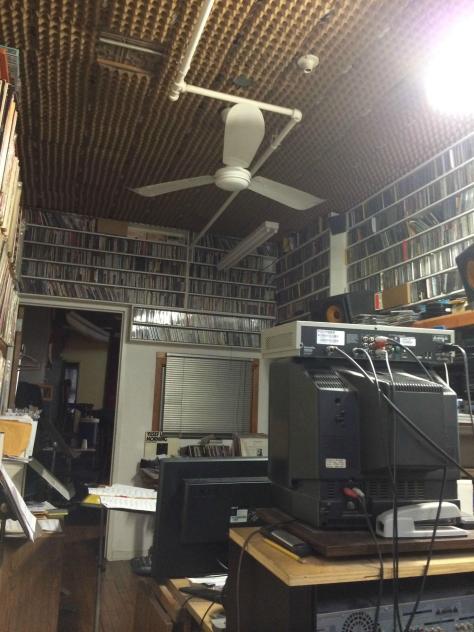As a continuation of the initial posting concerning KD’s record Afro-Cuban, this post will explore the session from March 29, 1955 which was first released on a 10” LP (BLP 5065). The session from March 29 included four tunes: “Minor’s Holiday,” “Afrodisia,” “Lotus Flower,” and “Basheer’s Dream.” Both sessions from January 30 and March 29 were released on a 12” LP on Blue in 1957 (BLP 5035) — but the personnel was slightly different. The team had grown over the hiatus from a sextet to an octet which comprised of KD, J. J. Johnson on trombone, Hank Mobley on tenor saxophone, Cecil Payne on baritone saxophone, Horace Silver on Piano, Oscar Pettiford on bass, Carlos “Potato” Valdes on conga, and Art Blakey on drums.
According to the liner notes from the 10” LP, the conga player, Carlos “Potato” Valdes, had only been in the States for only a couple months before Diz told KD about him and “Little Benny” Harris brought him to the rehearsal. Alfred Lion recalls, “He [Carlos Valdes] gassed them all.”
The tune “Basheer’s Dream” has an intriguing backstory to it — it sticks out as the only piece on the session that was not written by Kenny, but the composition and arrangement were indeed commissioned of reedman Gigi Gryce especially for the March 29th session. due to the fact that reedman Gigi Gryce. According to Rat Race Blues: The Musical Life of Gigi Gryce by Noal Cohen and Michael Fitzgerald this tune is one of first instances where Gryce’s Muslim name is presented to the public. Gryce’s full Muslim name was Basheer Qusim, which was the primary name he would use after his departure from the music business.
“Basheer’s Dream“ has an introduction reminiscent of two other Gryce compositions, “Shabozz” and “Up in Quincy’s Room” (both from Art Farmer recordings from 1955 and 1953 respectively) with the interval of a fourth as the prime voicing used in the horns to give a somewhat “exotic” sound. According to Fitzgerald and Noal, there was an unidentified percussionist (aside from Valdes) on the claves alongside Art Blakey on the drums. This is a very exciting snippet of information that was left out of all three releases’ liner notes from Blue Note: the 10” LP from 1955, the 12” LP from 1957, and the cd release. There has been speculation that drummer Richie Goldberg (prominent in the San Francisco jazz scene of the 1950s and 1960s) but no one has yet to confirm it. Another suspicion is that the mystery clave player was Gigi Gryce himself. This seems more of a feasible story because it was Gryce’s tune and it would not seem out of term for Gryce to sit in during the recording session to see how his composition was turning out. Sadly for Mr. Gryce, this is the only recorded version of “Basheer’s Dream.” It is unclear if it was predetermined that this would be the only recording of Gryce’s composition, as it was written for the date. If this were the case, it would certainly lend credence to the idea that Gryce sat in as the unidentified percussionist on the session — who wouldn’t want to be present for the one and only recording of their own composition?
And so, to sum up the session, I leave you with a quotation from KD himself concerning the Afro-Cuban motif present in all four tunes from the original liner notes from the 10” LP:
“I tried to write everything so that the rhythm would be useful throughout and would never get in the way.”
KD has done exactly that on this record. Leonard Feather concurs with KD’s self-reflection by writing, “As a consequence, the Cuban touch sounds as if it is a part of the whole, rather than something that has been superimposed on a jazz scene, as it is sometimes the case.” An example of this superimposition would be the live concerts of Dizzy Gillespie’s orchestra with Machito in the late 1940s and early 1950s. For further reading on the partnership between Dizzy Gillespie and Machito, see David Garcia’s article entitled “’We Both Speak African’: A Dialogic Study of Afro-Cuban Jazz.”
Stay tuned for future postings on Una Mas, In ‘N’ Out, Matador, and Trompeta Toccata.





